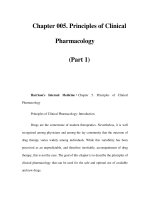CLINICAL HANDBOOK OF SCHIZOPHRENIA - PART 1 pps
Bạn đang xem bản rút gọn của tài liệu. Xem và tải ngay bản đầy đủ của tài liệu tại đây (324.58 KB, 67 trang )
CLINICAL HANDBOOK OF SCHIZOPHRENIA
CLINICAL
HANDBOOK OF
SCHIZOPHRENIA
Edited by
KIM T. MUESER
DILIP V. JESTE
THE GUILFORD PRESS
New York London
© 2008 The Guilford Press
A Division of Guilford Publications, Inc.
72 Spring Street, New York, NY 10012
www.guilford.com
All rights reserved
No part of this book may be reproduced, translated, stored in
a retrieval system, or transmitted, in any form or by any means,
electronic, mechanical, photocopying, microfilming, recording,
or otherwise, without written permission from the Publisher.
Printed in the United States of America
This book is printed on acid-free paper.
Last digit is print number: 987654321
The authors have checked with sources believed to be reliable in their efforts to provide
information that is complete and generally in accord with the standards of practice that
are accepted at the time of publication. However, in view of the possibility of human
error or changes in medical sciences, neither the authors, nor the editor and publisher,
nor any other party who has been involved in the preparation or publication of this
work warrants that the information contained herein is in every respect accurate or
complete, and they are not responsible for any errors or omissions or the results
obtained from the use of such information. Readers are encouraged to confirm the
information contained in this book with other sources.
Library of Congress Cataloging-in-Publication Data
Clinical handbook of schizophrenia / edited by Kim T. Mueser, Dilip V. Jeste.
p. ; cm.
Includes bibliographical references and index.
ISBN 978-1-59385-652-6 (hardcover : alk. paper)
1. Schizophrenia—Handbooks, manuals, etc. I. Mueser, Kim Tornvall.
II. Jeste, Dilip V. III. Title.
[DNLM: 1. Schizophrenia. WM 203 C641153 2008]
RC514.C564 2008
616.89′8—dc22
2007033713
ABOUT THE EDITORS
Kim T. Mueser, PhD, is a licensed clinical psychologist and a Professor in the Depart
-
ments of Psychiatry and Community and Family Medicine at the Dartmouth Medical
School in Hanover, New Hampshire. He was on the faculty of the Psychiatry Department
at the Medical College of Pennsylvania in Philadelphia until 1994, when he moved to
Dartmouth Medical School and joined the Dartmouth Psychiatric Research Center. Dr.
Mueser’s clinical and research interests include psychiatric rehabilitation for persons with
severe mental illnesses, intervention for co-occurring psychiatric and substance use disor-
ders, and the treatment of posttraumatic stress disorder. His research has been supported
by the National Institute of Mental Health (NIMH), the National Institute on Drug
Abuse, the Substance Abuse and Mental Health Services Administration, and the National
Alliance for Research on Schizophrenia and Depression (NARSAD). He has served on nu-
merous editorial boards, has published many journal articles and book chapters, and has
coauthored 10 books. In 2007 his book The Complete Family Guide to Schizophrenia
(with Susan Gingerich) received the National Alliance on Mental Illness NYC Metro Ken
Book Award for outstanding contributions to better understanding of mental illness.
Dilip V. Jeste, MD, is the Estelle and Edgar Levi Chair in Aging, Director of the Sam and
Rose Stein Institute for Research on Aging, and Distinguished Professor of Psychiatry and
Neurosciences, University of California, San Diego (UCSD) and VA San Diego Healthcare
System. He is also the Director of the NIMH-funded Advanced Center for Interventions
and Services Research at UCSD focusing on psychosis in late life, and of the John A.
Hartford Center of Excellence in Geriatric Psychiatry. Dr. Jeste was a research fellow, and
later, Chief of the Units on Movement Disorders and Dementias at NIMH before moving
to San Diego. He is the Principal Investigator on several research and training grants; has
published 8 books and over 500 articles in peer-reviewed journals and books; and is the
Editor-in-Chief of the American Journal of Geriatric Psychiatry. He is a member of the
Institute of Medicine of the National Academy of Sciences, and of the National Advisory
Mental Health Council of the National Institutes of Health. Dr. Jeste is a past President
of the American Association for Geriatric Psychiatry (AAGP) and the West Coast College
of Biological Psychiatry, and Founding President of the International College of Geriatric
Psychoneuropharmacology. His numerous awards include NIMH’s MERIT Award; the
Society of Biological Psychiatry’s A. E. Bennett Neuropsychiatric Research Award; AAGP’s
Senior Investigator Award; the American Psychiatric Association’s Research Award; Most
Distinguished Physician Teacher/Researcher Award from the American Association of
Physicians of Indian Origin; Asian Heritage Award for Excellence in Science, Technology,
and Research; American College of Psychiatrists’ Geriatric Research Award; and Distin
-
guished Investigator Award from NARSAD.
v
CONTRIBUTORS
Donald Addington, MD, Department of Psychiatry, Foothills Hospital, Calgary,
Alberta, Canada
Jean Addington, PhD, Department of Psychiatry, University of Toronto, and PRIME Clinic,
Centre for Addiction and Mental Health, Toronto, Ontario, Canada
Britton Ashley Arey, MD, private practice, Costa Mesa, California
Christine Barrowclough, PhD, Academic Division of Clinical Psychology, School
of Psychiatry and Behavioural Sciences, Wythenshawe Hospital, Manchester,
United Kingdom
Stephen J. Bartels, MD, Department of Psychiatry, New Hampshire–Dartmouth Psychiatric
Research Center, Dartmouth Medical School, Concord, New Hampshire
Paul Bebbington, MD, Department of Mental Health Sciences, Royal Free and University
College Medical School, London, United Kingdom
Deborah R. Becker, MEd, Department of Psychiatry, New Hampshire–Dartmouth
Psychiatric Research Center, Dartmouth Medical School, Concord, New Hampshire
Alan S. Bellack, PhD, Department of Psychiatry, University of Maryland School
of Medicine, Baltimore, Maryland
Jonathan Bindman, MD, PhD, Lambeth Hospital, London, United Kingdom
Gary R. Bond, PhD, Department of Psychology, Indiana University–Purdue University
Indianapolis, Indianapolis, Indiana
Catherine Briand, PhD, Faculty of Medicine, University of Montreal,
Montreal, Quebec, Canada
Tyrone D. Cannon, PhD, Departments of Psychology and Psychiatry and Biobehavioral
Sciences, University of California, Los Angeles, Los Angeles, California
William T. Carpenter, Jr., MD, Departments of Psychiatry and Pharmacology
and Maryland Psychiatric Research Center, University of Maryland School
of Medicine, Baltimore, Maryland
David J. Castle, MD, Mental Health Research Institute, University of Melbourne,
Parkville, Victoria, Australia
Robin E. Clark, PhD, Center for Health Policy and Research, University of Massachusetts
Medical School, Shrewsbury, Massachusetts
vii
Carl I. Cohen, MD, Division of Geriatric Psychiatry, State University of New York
Downstate Medical Center, Brooklyn, New York
Marc Corbière, PhD, Institute of Health Promotion Research, University of British
Columbia, Vancouver, British Columbia, Canada
Patrick W. Corrigan, PsyD, Institute of Psychology, Illinois Institute of Technology,
Chicago, Illinois
John G. Cottone, PhD, Stony Brook Psychotherapy and Wellness, Stony Brook, New York
Gary S. Cuddeback, PhD, Department of Social Work, Cecil G. Sheps Center for Health
Services Research, University of North Carolina at Chapel Hill, Chapel Hill, North Carolina
Larry Davidson, PhD, Program on Recovery and Community Health, School of Medicine
and Institution for Social and Policy Studies, Yale University, New Haven, Connecticut
Kenneth L. Davis, MD, Department of Psychiatry, Mount Sinai School of Medicine,
New York, New York
Natalie L. DeLuca, PhD, National Center for Organizational Development, VA Healthcare
System of Ohio, Cincinnati, Ohio
Lisa Dixon, MD, MPH, Division of Health Services Research, University of Maryland
School of Medicine, Baltimore, Maryland
Christian R. Dolder, PharmD, Wingate University School of Pharmacy, Wingate,
North Carolina
Jonathan Downar, MD, PhD, Department of Psychiatry, University of Toronto,
Toronto, Ontario, Canada
Robert E. Drake, MD, PhD, Department of Psychiatry, New Hampshire–Dartmouth
Psychiatric Research Center, Dartmouth Medical School, Concord, New Hampshire
Lauren M. Ellman, PhD, New York State Psychiatric Institute, Columbia University,
New York, New York
Lisa T. Eyler, PhD, Department of Psychiatry, University of California, San Diego,
La Jolla, California
Walid K. H. Fakhoury, PhD, Unit for Social and Community Psychiatry, Newham Centre
for Mental Health, London, United Kingdom
Roger D. Fallot, PhD, Community Connections, Washington, DC
Alan Felix, MD, Department of Psychiatry, College of Physicians and Surgeons, Columbia
University, New York, New York
Richard B. Ferrell, MD, Department of Psychiatry, Dartmouth–Hitchcock Medical Center,
Dartmouth Medical School, Lebanon, New Hampshire
Bernard A. Fischer IV, MD, Department of Psychiatry, University of Maryland School
of Medicine, Baltimore, Maryland
Frederick J. Frese III, PhD, Summit County Recovery Project, Akron, Ohio
Matthew A. Fuller, PharmD, Pharmacy Service, Louis Stokes Cleveland Department
of Veterans Affairs Medical Center, Brecksville, Ohio
Susan Gingerich, MSW, private practice, Philadelphia, Pennsylvania
Stephen J. Glatt, PhD, Department of Psychiatry, University of California, San Diego,
La Jolla, California
Richard J. Goscha, MSW, School of Social Welfare, University of Kansas,
Lawrence, Kansas
viii Contributors
Gillian Haddock, PhD, Academic Division of Clinical Psychology, University of
Manchester, Manchester, United Kingdom
Heinz Häfner, PhD, Schizophrenia Research Unit, Central Institute of Mental Health,
Mannheim, Germany
Wolfram an der Heiden, DiplPsych, Schizophrenia Research Unit, Central Institute of
Mental Health, Mannheim, Germany
Marnin J. Heisel, PhD, Departments of Psychiatry and Epidemiology and Biostatistics,
Schulich School of Medicine and Dentistry, University of Western Ontario, London,
Ontario, Canada
Dan Herman, DSW, Department of Clinical Epidemiology, Mailman School of Public
Health, Columbia University, New York, New York
Mustafa M. Husain, MD, Department of Psychiatry, University of Texas Southwestern
Medical Center at Dallas, Dallas, Texas
Dilip V. Jeste, MD, Institute for Research on Aging and Departments of Psychiatry
and Neurosciences, University of California, San Diego, and VA San Diego Healthcare
System, La Jolla, California
Shitij Kapur, MD, PhD, Centre for Addiction and Mental Health and Department of
Psychiatry, University of Toronto, Toronto, Ontario, Canada
David J. Kavanagh, PhD, Department of Psychiatry, University of Queensland,
Brisbane, Australia
Alex Kopelowicz, MD, San Fernando Mental Health Center, Granada Hills, California
Elizabeth Kuipers, PhD, Department of Psychology, Institute of Psychiatry, Kings College
London, London, United Kingdom
Sanjiv Kumra, MD, Department of Psychiatry, University of Minnesota,
Minneapolis, Minnesota
Eric C. Kutscher, PharmD, Department of Pharmacy Practice, South Dakota State
University College of Pharmacy, Brookings, South Dakota; Department of Psychiatry,
Sanford School of Medicine, University of South Dakota School of Medicine,
Vermillion, South Dakota; Department of Psychiatry, Avera Behavioral Health Center,
Sioux Falls, South Dakota
Jonathan E. Larson, PhD, Rehabilitation Psychology Faculty, Institute of Psychology,
Illinois Institute of Technology, Chicago, Illinois
Helen Lavretsky, MD, MS, Department of Psychiatry and Behavioral Sciences, University
of California, Los Angeles, Los Angeles, California
William B. Lawson, MD, PhD, Department of Psychiatry, Howard University Hospital,
Washington, DC
Tania Lecomte, PhD, Department of Psychology, University of Montreal,
Montreal, Quebec, Canada
Robert Paul Liberman, MD, Department of Psychiatry and Behavioral Sciences, University
of California, Los Angeles, Los Angeles, California
Fiona Lobban, PhD, Academic Division of Clinical Psychology, School of Psychiatry
and Behavioural Sciences, University of Manchester, Manchester, United Kingdom
James B. Lohr, MD, Department of Psychiatry, University of California, San Diego,
La Jolla, California
Contributors ix
Subramoniam Madhusoodanan, MD, St. John’s Episcopal Hospital, Far Rockaway,
New York; Department of Psychiatry, State University of New York Downstate
Medical Center, Brooklyn, New York
Stephen R. Marder, MD, Semel Institute for Neuroscience and Human Behavior and
Department of Psychiatry, David Geffen School of Medicine, University of California,
Los Angeles, Los Angeles, California
Thomas W. McAllister, MD, Department of Psychiatry, Dartmouth–Hitchcock Medical
Center, Dartmouth Medical School, Lebanon, New Hampshire
Shawn M. McClintock, PhD, Department of Psychiatry, University of Texas Southwestern
Medical Center at Dallas, Dallas, Texas
John R. McQuaid, PhD, Department of Psychiatry, University of California, San Diego,
La Jolla, California
Thomas W. Meeks, MD, Department of Psychiatry, University of California, San Diego,
La Jolla, California
Matthew R. Merrens, PhD, New Hampshire–Dartmouth Psychiatric Research Center,
Dartmouth Medical School, Lebanon, New Hampshire
Alexander L. Miller, MD, Department of Psychiatry, University of Texas Health Science
Center at San Antonio, San Antonio, Texas
Laura Miller, MD, Department of Psychiatry, University of Illinois at Chicago,
Chicago, Illinois
David J. Moore, PhD, Department of Psychiatry, University of California, San Diego,
La Jolla, California
Vera Morgan, MA, School of Psychiatry and Clinical Neurosciences, University of Western
Australia, Perth, Australia
Anthony P. Morrison, PhD, Department of Clinical Psychology, Mental Health Services,
Manchester, United Kingdom
Joseph P. Morrissey, PhD, Departments of Health Policy and Administration and
Psychiatry and Cecil G. Sheps Center for Health Services Research, University of
North Carolina at Chapel Hill, Chapel Hill, North Carolina
Lorna L. Moser, MS, Department of Psychology, Indiana University–Purdue University
Indianapolis, Indianapolis, Indiana
Kim T. Mueser, PhD, Department of Psychiatry, New Hampshire–Dartmouth Psychiatric
Research Center, Dartmouth Medical School, Concord, New Hampshire
Barnaby Nelson, PhD, The PACE Clinic, ORYGEN Youth Health, Parkville, Victoria,
Australia
Joanne Nicholson, PhD, Department of Psychiatry and Community Health Center for
Mental Health Services Research, University of Massachusetts Medical School,
Worcester, Massachusetts
Thomas O’Hare, MSW, PhD, Graduate School of Social Work, Boston College,
Boston, Massachusetts
Fred C. Osher, MD, Health Systems and Services Policy Justice Center, Council of State
Governments, Bethesda, Maryland
Barton W. Palmer, PhD, Department of Psychiatry, University of California, San Diego,
La Jolla, California
x Contributors
Roger H. Peters, PhD, Department of Mental Health Law and Policy, Louis de la Parte
Florida Mental Health Institute, University of South Florida, Tampa, Florida
Stefan Priebe, PhD, Unit for Social and Community Psychiatry, Newham Centre
for Mental Health, London, United Kingdom
Najeeb Ranginwala, MD, Department of Psychiatry, University of Texas Southwestern
Medical Center at Dallas, Dallas, Texas
Charles A. Rapp, MSW, PhD, School of Social Welfare, University of Kansas,
Lawrence, Kansas
Priscilla Ridgway, PhD, Connecticut Mental Health Center, Yale University, New Haven,
Connecticut
David Roe, PhD, Department of Community Mental Health, Faculty of Social Welfare
and Health Studies, University of Haifa, Haifa, Israel
Stanley D. Rosenberg, PhD, Department of Psychiatry and Dartmouth Trauma Intervention
Research Center, Dartmouth Medical School, Lebanon, New Hampshire
Abraham Rudnick, MD, PhD, Departments of Psychiatry and Philosophy, University
of Western Ontario, London, Ontario, Canada
Ingrid B. Rystedt, MD, PhD, Department of Community and Family Medicine, New
Hampshire–Dartmouth Psychiatric Research Center, Dartmouth Medical School,
Lebanon, New Hampshire
Martha Sajatovic, MD, Department of Psychiatry, Case Western Reserve University School
of Medicine, Cleveland, Ohio
Mihail Samnaliev, PhD, Center for Health Policy and Research, University
of Massachusetts Medical School, Shrewsbury, Massachusetts
Antonio M. Santos, PhD, private practice, La Jolla, California
Gauri N. Savla, MA, MS, Department of Psychiatry, University of California, San Diego,
La Jolla, California
Mary V. Seeman, MD, Centre for Addiction and Mental Health, University of Toronto,
Toronto, Ontario, Canada
Jennifer J. Shaw, MD, Guild Lodge Medium Secure Unit, Lancashire, United Kingdom
Pattie B. Sherman, BA, Department of Psychology, University of South Florida,
Tampa, Florida
Margaret V. Sherrer, MSW, Department of Psychology, Lyndon State College, Lyndonville,
Vermont
Mounir Soliman, MD, Department of Psychiatry, University of California, San Diego,
La Jolla, California
Daniel G. Stewart, MD, Department of Psychiatry, Mount Sinai School of Medicine,
New York, New York
Donald Stolar, PhD, Department of Psychiatry, University of California, Los Angeles,
Los Angeles, California
Ezra Susser, MD, Department of Epidemiology, Mailman School of Public Health,
Columbia University, New York, New York
Wendy N. Tenhula, PhD, Department of Psychiatry, University of Maryland School
of Medicine, Baltimore, Maryland
Contributors xi
Graham Thornicroft, MD, PhD, Institute of Psychiatry, King’s College London,
London, United Kingdom
Ipsit V. Vahia, MD, Sam and Rose Stein Institute of Research for Aging, University of
California, San Diego, La Jolla, California
Vihang N. Vahia, MD, Department of Psychiatry, Dr. R. N. Cooper Hospital and Seth
G. S. Medical College, Mumbai, India
Dawn I. Velligan, PhD, Department of Psychiatry, University of Texas Health Science
Center at San Antonio, San Antonio, Texas
Charles Weijer, MD, PhD, Department of Philosophy, Talbot College, University of
Western Ontario, London, Ontario, Canada
Karen Wohlheiter, PhD, Department of Psychiatry, University of Maryland School of
Medicine, Baltimore, Maryland
Til Wykes, PhD, Institute of Psychiatry, King’s College London, London, United Kingdom
Alison Yung, MD, Department of Psychiatry, University of Melbourne, Parkville, Victoria,
Australia
xii Contributors
PREFACE
S
chizophrenia is arguably the most serious major psychiatric disorder, usually develop
-
ing in late adolescence or early adulthood, and often having a profound effect over the
lifetime on daily functioning. People with schizophrenia frequently have difficulties living
independently and caring for themselves, working or attending school, fulfilling parental
or other role obligations, and enjoying close relationships and rewarding leisure activities
(American Psychiatric Association, 2000). Although schizophrenia develops in about 1 in
100 individuals, it accounts for a disproportionate share of treatment costs and, accord-
ing to the World Health Organization, is ranked as the second highest contributor to
overall burden of diseases, behind cardiovascular disease (Murray & Lopez, 1996).
Despite the severity of schizophrenia, in recent years there has been enormous prog-
ress in our understanding of the illness, and the treatment for it is a rapidly evolving field.
Two to three decades ago only a few treatments had been shown to be effective for
schizophrenia, and most people with the illness continued to be substantially disabled
throughout their lives. Although no “cure” for schizophrenia is currently known, a grow-
ing number of treatments, both pharmacological and psychosocial, have been shown to
be effective. Of equal or greater importance, there has been a sea change in how the treat
-
ment, course, and outcome of schizophrenia are conceptualized. Whereas treatment used
to focus primarily on a reduction or containment of psychopathology, traditional con
-
cepts of medical recovery have been challenged and recently have given way to new and
more meaningful definitions of recovery that emphasize improved functioning, client self-
direction, empowerment, and hope (Anthony, 1993; Bellack, 2006; Deegan, 1988). There
are now solid grounds for optimism in the treatment of schizophrenia, and the potential
to help individuals with this disorder lead rewarding and productive lives. The change in
the perception about schizophrenia (although still quite limited in the public mind) may
be exemplified by two films that won the Oscar for the best film of the year: One Flew
over the Cuckoo’s Nest in 1976 versus A Beautiful Mind in 2002. The former depicted
prevalent treatment of serious mental illnesses within a rigid, authoritarian, impersonal
chronic mental institution, whereas the latter focused on a person with schizophrenia
who not only had a remission of his illness, but also received a Nobel Prize for his earlier
scientific work.
Because knowledge about schizophrenia and its treatment has grown at an exponen
-
tial rate in recent years, clinicians have a critical need to keep abreast of the latest devel
-
opments, within the constraints of limited time, resources, and their own expertise.
Specifically, clinicians require access to authoritative information and recommended
xiii
resources, written in nontechnical language and covering a broad range of topics related
to schizophrenia and its treatment. The Clinical Handbook of Schizophrenia is designed
to meet these practical needs of clinicians working with individuals with schizophrenia
and their families.
Each chapter in the Handbook has been written by a world authority on the topic, in
plain language with minimal (or no) references in the text, and a resource list of refer
-
ences and recommended readings at the end. All of the chapters on treatment are aimed
at providing not only guidelines to clinicians about implementing specific treatment ap
-
proaches or working with particular populations but also succinct reviews of the research
literature supporting these methods. The major “take-home” messages on each topic are
summarized in a series of “Key Points” at the end of each chapter. The selection of topics,
the writing style, the emphasis on briefly summarizing research findings rather than
exhaustively reviewing the scientific literature, and the focus on providing practical clini
-
cal recommendations are intended to make the Handbook an interesting and useful re
-
source for clinicians. In addition, the comprehensive yet accessible nature of this book
will be of interest to students in the health professions (e.g., clinical psychology, psychia
-
try, general medical practice or family medical practice, psychiatric rehabilitation, social
work, nursing, occupational therapy, family and marital counselors), mental health ad
-
ministrators and policymakers, relatives and other support persons, and individuals with
schizophrenia themselves.
The Handbook is divided into eight different sections, each covering a variety of
topic areas. Part I focuses on Core Science and Background Information on schizophre-
nia. The section begins with a chapter on the history of the concept of schizophrenia, fol-
lowed by chapters on epidemiology, biological theories, brain imaging, neuropathology,
genetics, and pre- and perinatal influences on the development of the illness. This section
also includes chapters on psychosocial factors in schizophrenia, psychopathology, cogni-
tive functioning, and the course and outcome of the disease.
Part II addresses practical issues related to Assessment and Diagnosis of schizophre-
nia. The first chapter in this section addresses clinical methods for the diagnosis of schizo-
phrenia and related schizophrenia spectrum disorders (e.g., schizoaffective disorder and
schizophreniform disorder), which are of critical importance considering symptom over
-
lap in schizophrenia and major mood disorders. The second chapter addresses the assess
-
ment of medical comorbidity, which is now recognized as the most important factor con
-
tributing to premature mortality for individuals with schizophrenia (Jeste, Gladsjo,
Lindamer, & Lacro, 1996). A third chapter addresses the assessment of psychosocial
functioning—a crucial topic considering that impaired social functioning is a hallmark of
schizophrenia. The final chapter in this section provides a framework for treatment plan
-
ning and ongoing monitoring of outcomes.
Part III addresses the Somatic Treatment of schizophrenia. The primary focus of this
section is on pharmacological approaches, which are widely accepted as the “mainstay”
in the treatment of schizophrenia. Although not everyone with schizophrenia benefits
from medication, the vast majority do, and effective pharmacological treatment makes it
possible for many individuals to participate in psychosocial treatment. This section also
includes a chapter on the use of electroconvulsive therapy for schizophrenia, a frequently
misunderstood but potentially useful treatment approach for a small proportion of indi
-
viduals with intractable symptoms.
Part IV addresses the Psychosocial Treatment of schizophrenia. Extensive research in
recent years has demonstrated the effectiveness of a variety of different approaches to
psychosocial treatment and self-help for schizophrenia. The chapters in this section
reflect the broad range of psychosocial interventions for schizophrenia, including the in
-
xiv Preface
corporation of environmental supports into individuals’ lives to facilitate medication ad
-
herence and improve daily functioning, family intervention to educate relatives about
schizophrenia and the principles of its management, cognitive-behavioral therapy for psy
-
chosis, social skills training, cognitive rehabilitation, vocational rehabilitation, and train
-
ing in illness self-management skills. In addition, the specific application of psychosocial
treatments in a group format is covered in one chapter, whereas another describes the
principles of supported housing. The final chapter in this section addresses the role of
self-help in promoting coping and recovery from schizophrenia.
Part V focuses on Systems of Care for delivering treatment to people with schizo
-
phrenia. The initial chapter in this section is devoted to the role of clinical case manage
-
ment in coordinating mental health treatment, followed by chapters on strengths-based
case management and the assertive community treatment (ACT) model. In addition, one
chapter addresses treatment in emergency room, inpatient, and residential settings,
whereas another describes the treatment of schizophrenia in jails and prisons, a topic of
major interest considering the dramatic and distressing growth in recent years of individ
-
uals with severe mental illness in the criminal justice system (Torrey, 1995).
Part VI addresses a range of Special Populations and Problems among the broad
group of individuals with schizophrenia. The first chapter describes the treatment of the
first episode of schizophrenia, a topic that has garnered a great deal of interest over the
past decade. The second addresses the treatment of the prodromal phase of schizophre-
nia, a new and promising area of research. The third chapter describes the treatment of
schizophrenia in older individuals, also a growing topic of interest considering the rapidly
growing population of people over age 50 with the illness. This section also contains
chapters on common problems experienced by individuals with schizophrenia, including
aggression and violence, housing instability and homelessness, medical comorbidity, intel-
lectual disability, trauma and posttraumatic stress disorder, and substance abuse. Finally,
one chapter describes the treatment of individuals with schizophrenia who are parents,
and strategies for ensuring that their children’s needs are met. This is a topic of consider-
able importance, especially for women with schizophrenia who have children, but
frequently have difficulty fulfilling their parental obligations (Apfel & Handler, 1993).
Another chapter describes the treatment of schizophrenia in children and adolescents.
This section concludes with a chapter on suicide.
Part VII addresses Policy, Legal, and Social Issues related to the treatment of schizo
-
phrenia. One chapter in this section discusses the economics of schizophrenia, including
estimates of the direct and indirect costs of the illness. Two chapters deal with legal as
-
pects of the care of people with schizophrenia, including involuntary commitment to
treatment and treatment in jail and prison settings. One chapter in this section addresses
the vexing problem of stigma, including both social rejection and fear of people with the
illness, and the dispiriting effects of self-stigma, or the integration of social beliefs about
the illness into one’s self-concept. Another chapter addresses implementation of evidence-
based practices for the treatment of schizophrenia. This topic is of particular importance,
because research has shown that a wide range of treatments are effective for schizophre
-
nia, but there has been an unacceptably long delay between the discovery of effective
treatments and access to them in public mental health care settings (Drake et al., 2001;
Lehman & Steinwachs, 1998). The final chapter in this section addresses schizophrenia in
developing nations, a topic that has been the focus of increasing attention in recent years.
Part VIII is devoted to Special Topics related to the treatment of schizophrenia. The sec
-
tion begins with a chapter defining criteria for remission of schizophrenia, followed by a
chapter on growth and recovery that addresses the paradigm shift from approaching schizo
-
phrenia mainly in terms of psychopathology and impairment to exploring the potential of
Preface xv
individuals with the illness to achieve personally meaningful recovery and to continue to
grow as people. The next chapter in this section addresses issues related to gender, followed
by a chapter that considers the topic of quality of life, including both subjective and objec
-
tive approaches to the issue. Two chapters in this section address the topics of religion (and
spirituality) and sexuality, both of paramount importance in the lives of many people with
and without mental illness, but frequently neglected in books and guidelines describing the
treatment of schizophrenia. One chapter addresses the topic of schizophrenia in African
Americans; the extensive research by this chapter’s author and his group may have impor
-
tant and useful implications for understanding the complex interrelationships between
schizophrenia and race/ethnicity. This section concludes with a chapter on ethics, an in
-
creasingly complex topic in both research and clinical practice as treatment options multi
-
ply, and the importance of engaging and empowering individuals with schizophrenia in
making decisions about their own treatment is now recognized.
The treatment of schizophrenia has now evolved to the point that clinicians, individ
-
uals with the illness, and their loved ones have numerous choices, and a more hopeful
future. However, to take advantage of the latest developments in the causes and the treat
-
ment of schizophrenia, the people interested in this topic need an authoritative yet acces
-
sible guide. We hope that our readers will find the Clinical Handbook of Schizophrenia a
valuable resource in furthering their understanding of schizophrenia, and in guiding their
treatment decisions. Ultimately, broad dissemination of scientifically accurate and clini-
cally relevant information is the best means of reducing social stigma against serious
mental illnesses such as schizophrenia.
K
IM T. MUESER
DILIP V. J ESTE
REFERENCES
American Psychiatric Association. (2000). Diagnostic and statistical manual of mental disorders (4th
ed., text rev.). Washington, DC: Author.
Anthony, W. A. (1993). Recovery from mental illness: The guiding vision of the mental health service
system in the 1990s. Psychosocial Rehabilitation Journal, 16, 11–23.
Apfel, R. J., & Handler, M. E. (1993). Madness and the loss of motherhood: Sexuality, reproduction,
and long-term mental illness. Washington, DC: American Psychiatric Press.
Bellack, A. S. (2006). Scientific and consumer models of recovery in schizophrenia: Concordance,
contrasts, and implications. Schizophrenia Bulletin, 32, 432–442.
Deegan, P. E. (1988). Recovery: The lived experience of rehabilitation. Psychosocial Rehabilitation
Journal, 11, 11–19.
Drake, R.E., Goldman, H.H., Leff, H.S., Lehman, A.F., Dixon,L., Mueser,K. T., etal. (2001). Imple
-
menting evidence-based practices in routine mental health service settings. Psychiatric Services,
52, 179–182.
Jeste, D. V., Gladsjo, J. A., Lindamer, L. A., & Lacro, J. P. (1996). Medical comorbidity in schizophre
-
nia. Schizophrenia Bulletin, 22(3), 413–430.
Lehman, A. F., & Steinwachs, D. M. (1998). Patterns of usual care for schizophrenia: Initial results
from the Schizophrenia Patient Outcomes Research Team (PORT) client survey. Schizophrenia
Bulletin, 24, 11–20.
Murray, C. J. L., & Lopez,A. D. (Eds.). (1996).The global burden ofdisease: A comprehensive assess
-
ment of mortality and disability from diseases, injuries, and risk factors in 1990 and projected to
2020. Cambridge, MA: HarvardSchool of Public Health, on behalfof the World Health Organi
-
zation and the World Bank, Harvard University Press.
Torrey, E. F. (1995). Jails and prisons: American’s new mental hospitals [Editorial]. American Journal
of Public Health, 85, 1611–1613.
xvi Preface
CONTENTS
I. CORE SCIENCE AND BACKGROUND INFORMATION
CHAPTER 1 History of Schizophrenia as a Psychiatric Disorder 3
Helen Lavretsky
CHAPTER
2 Epidemiology 14
David J. Castle and Vera Morgan
CHAPTER
3 Biological Theories 25
Jonathan Downar and Shitij Kapur
CHAPTER
4 Brain Imaging 35
Lisa T. Eyler
CHAPTER
5 Neuropathology 44
Daniel G. Stewart and Kenneth L. Davis
CHAPTER
6 Genetics 55
Stephen J. Glatt
CHAPTER
7 Environmental Pre- and Perinatal Influences in Etiology 65
Lauren M. Ellman and Tyrone D. Cannon
CHAPTER
8 Psychosocial Factors 74
Paul Bebbington and Elizabeth Kuipers
CHAPTER
9 Psychopathology 82
Ipsit V. Vahia and Carl I. Cohen
CHAPTER
10 Cognitive Functioning 91
Gauri N. Savla, David J. Moore, and Barton W. Palmer
CHAPTER
11 Course and Outcome 100
Heinz Häfner and Wolfram an der Heiden
xvii
II. ASSESSMENT AND DIAGNOSIS
CHAPTER 12 Diagnostic Interviewing 117
Abraham Rudnick and David Roe
CHAPTER
13 Assessment of Co-Occurring Disorders 125
Karen Wohlheiter and Lisa Dixon
CHAPTER
14 Assessment of Psychosocial Functioning 135
Tania Lecomte, Marc Corbière, and Catherine Briand
CHAPTER
15 Treatment Planning 145
Alexander L. Miller and Dawn I. Velligan
III. SOMATIC TREATMENT
CHAPTER 16 Antipsychotics 159
Eric C. Kutscher
CHAPTER
17 Side Effects of Antipsychotics 168
Christian R. Dolder
CHAPTER
18 Clozapine 178
Martha Sajatovic, Subramoniam Madhusoodanan,
and Matthew A. Fuller
CHAPTER
19 Other Medications 186
Britton Ashley Arey and Stephen R. Marder
CHAPTER
20 Electroconvulsive Therapy 196
Shawn M. McClintock, Najeeb Ranginwala, and Mustafa M. Husain
IV. PSYCHOSOCIAL TREATMENT
CHAPTER 21 Environmental Supports 207
Dawn I. Velligan and Alexander L. Miller
CHAPTER
22 Family Intervention 214
Christine Barrowclough and Fiona Lobban
CHAPTER
23 Cognitive-Behavioral Therapy 226
Anthony P. Morrison
CHAPTER
24 Social Skills Training 240
Wendy N. Tenhula and Alan S. Bellack
CHAPTER
25 Cognitive Rehabilitation 249
Til Wykes
CHAPTER
26 Vocational Rehabilitation 261
Deborah R. Becker
xviii Contents
CHAPTER 27 Illness Self-Management Training 268
Kim T. Mueser and Susan Gingerich
CHAPTER
28 Group Therapy 279
John R. McQuaid
CHAPTER
29 Supported Housing 287
Priscilla Ridgway
CHAPTER
30 Self-Help Activities 298
Frederick J. Frese III
V. SYSTEMS OF CARE
CHAPTER 31 Clinical Case Management 309
Margaret V. Sherrer and Thomas O’Hare
CHAPTER
32 Strengths-Based Case Management 319
Charles A. Rapp and Richard J. Goscha
CHAPTER
33 Assertive Community Treatment 329
Natalie L. DeLuca, Lorna L. Moser, and Gary R. Bond
CHAPTER
34 Emergency, Inpatient, and Residential Treatment 339
Mounir Soliman, Antonio M. Santos, and James B. Lohr
CHAPTER
35 Treatment in Jails and Prisons 354
Roger H. Peters, Pattie B. Sherman, and Fred C. Osher
VI. SPECIAL POPULATIONS AND PROBLEMS
CHAPTER 36 First-Episode Psychosis 367
Donald Addington and Jean Addington
CHAPTER
37 Treatment of the Schizophrenia Prodrome 380
Barnaby Nelson and Alison Yung
CHAPTER
38 Older Individuals 390
Thomas W. Meeks and Dilip V. Jeste
CHAPTER
39 Understanding and Working with Aggression, Violence,
and Psychosis
398
Gillian Haddock and Jennifer J. Shaw
CHAPTER
40 Housing Instability and Homelessness 411
Alan Felix, Dan Herman, and Ezra Susser
CHAPTER
41 Medical Comorbidity 424
Ingrid B. Rystedt and Stephen J. Bartels
CHAPTER
42 Intellectual Disability and Other Neuropsychiatric Populations 437
Richard B. Ferrell and Thomas W. McAllister
Contents xix
CHAPTER 43 Trauma and Posttraumatic Stress Syndromes 447
Stanley D. Rosenberg and Kim T. Mueser
CHAPTER
44 Management of Co-Occurring Substance Use Disorders 459
David J. Kavanagh
CHAPTER
45 Parenting 471
Joanne Nicholson and Laura Miller
CHAPTER
46 Children and Adolescents 481
John G. Cottone and Sanjiv Kumra
CHAPTER
47 Suicide 491
Marnin J. Heisel
VII. POLICY, LEGAL, AND SOCIAL ISSUES
CHAPTER 48 The Economics of Schizophrenia 507
Mihail Samnaliev and Robin E. Clark
CHAPTER
49 Involuntary Commitment 516
Jonathan Bindman and Graham Thornicroft
CHAPTER
50 Jail Diversion 524
Joseph P. Morrissey and Gary S. Cuddeback
CHAPTER
51 Stigma 533
Patrick W. Corrigan and Jonathon E. Larson
CHAPTER
52 Evidence-Based Practices 541
Matthew R. Merrens and Robert E. Drake
CHAPTER
53 Schizophrenia in Developing Countries 549
Vihang N. Vahia and Ipsit V. Vahia
VIII. SPECIAL TOPICS
CHAPTER 54 Remission 559
Bernard A. Fischer IV and William T. Carpenter, Jr.
CHAPTER
55 Recovery 566
David Roe and Larry Davidson
CHAPTER
56 Gender 575
Mary V. Seeman
CHAPTER
57 Quality of Life 581
Stefan Priebe and Walid K. H. Fakhoury
CHAPTER
58 Spirituality and Religion 592
Roger D. Fallot
xx Contents
CHAPTER 59 Sexuality 604
Alex Kopelowicz, Robert Paul Liberman, and Donald Stolar
CHAPTER
60 Schizophrenia in African Americans 616
William B. Lawson
CHAPTER
61 Ethics 624
Abraham Rudnick and Charles Weijer
Index 631
Contents xxi
PART I
CORE SCIENCE AND
BACKGROUND INFORMATION
CHAPTER 1
HISTORY OF SCHIZOPHRENIA
AS A PSYCHIATRIC DISORDER
HELEN LAVRETSKY
HISTORY OF CLINICAL DIAGNOSIS OF SCHIZOPHRENIA
Schizophrenia is one of the most serious psychiatric disorders. It carries a lifetime risk of
approximately 1%. The symptoms of schizophrenia remain perhaps the most mysterious
form of human psychological experience. The early onset of the disease, most often oc-
curring between ages 15 and 30 years, and its chronic course make this a particularly dis-
abling disorder for patients and their families. Chronic disability results primarily from
the negative and cognitive symptoms, whereas acute relapses result from exacerbations of
the positive psychotic symptoms, such as delusions and hallucinations. The social and
economic impact of the disorder on society and families is enormous.
Despite extensive research, the international psychiatric community still lacks diag
-
nostic precision, clarity of etiology, and knowledge of underlying pathophysiology of
schizophrenia. Disputes over concepts and appropriate models of mental illness extend
back to classical times. Reports of schizophrenia-like illness can be found even in ancient
literature. However, the first comprehensive description dates to the beginning of the
18th century. Schizophrenia was defined as an early dementia in the 19th century. French
psychiatrist, Benedict Augustine Morel (1809–1873), coined the term dementia praecox,
or “precocious dementia.”
The modern concept of schizophrenia was first formalized by the German psychia
-
trist Émil Kraepelin (1856–1927), who integrated contemporary descriptions of catatonia
by Kahlbaum (1863), and hebephrenia by Hecker (1871), and his own “dementia para
-
noia” into a single disorder with an early onset, poor prognosis, and 36 “psychic” symp
-
toms and 19 “bodily” or physical symptoms. Among the most common psychic symp
-
toms were hallucinations occurring in all sensory modalities, but most commonly
“hallucinations of hearing.” Although Kraepelin defined dementia praecox on the basis
of the characteristic course and outcome of a cluster of symptoms and signs, he also
3









